Container gardening has revolutionized the way urban and small-space gardeners approach landscaping. Whether you have a balcony, patio, rooftop, or backyard, containers offer flexibility, mobility, and creativity. However, arranging them effectively is just as important as choosing the right plants. A well-thought-out container arrangement creates visual harmony, aesthetic appeal, and a sense of balance, transforming even small spaces into inviting green retreats.
This article explores principles, strategies, and practical tips for arranging containers to achieve a balanced, cohesive garden look, while maximizing both beauty and functionality.
1. Understanding Garden Balance
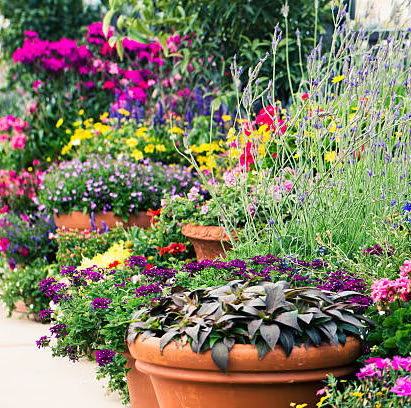
Creating a visually appealing garden begins with understanding balance:
- Symmetrical Balance: Achieved by placing identical or similar containers and plants on either side of a focal point. It conveys a sense of order and formality.
- Asymmetrical Balance: Involves placing different-sized containers and plant types in a way that feels visually balanced. This method is more dynamic and natural-looking.
- Radial Balance: Containers and plants radiate from a central point, ideal for circular patios or balcony corners.
Recognizing these balance types allows gardeners to strategically plan container placements for maximum aesthetic impact.
2. Selecting Containers for Harmony
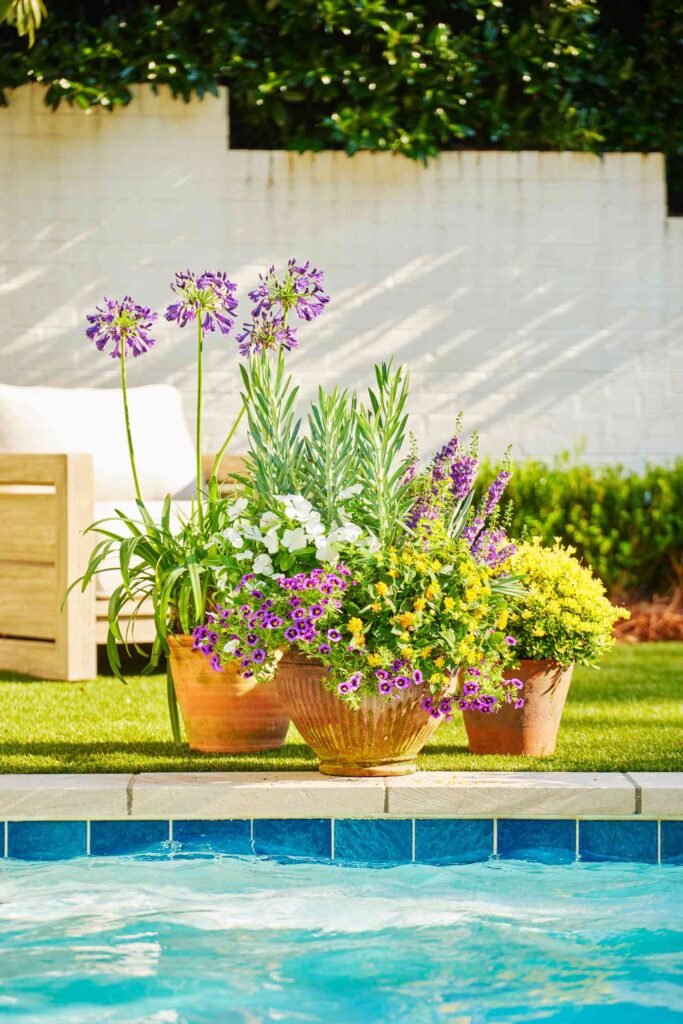
The choice of containers influences the overall balance and flow of the garden:
- Size and Proportion: Mix large, medium, and small containers to create depth. Avoid having too many oversized pots, which can overwhelm the space.
- Shape Variety: Round, square, rectangular, and tiered pots add visual interest. Pairing geometric shapes thoughtfully enhances symmetry or asymmetry.
- Material Choices: Use terracotta, ceramic, plastic, or metal containers. A consistent material palette maintains harmony, while contrasting textures can create focal points.
- Color Coordination: Neutral colors blend seamlessly, while bright colors highlight specific areas or plants. Ensure that colors complement each other to avoid visual clutter.
Selecting containers with attention to size, shape, material, and color establishes a foundation for a balanced garden design.
3. Choosing Plants for Visual Balance
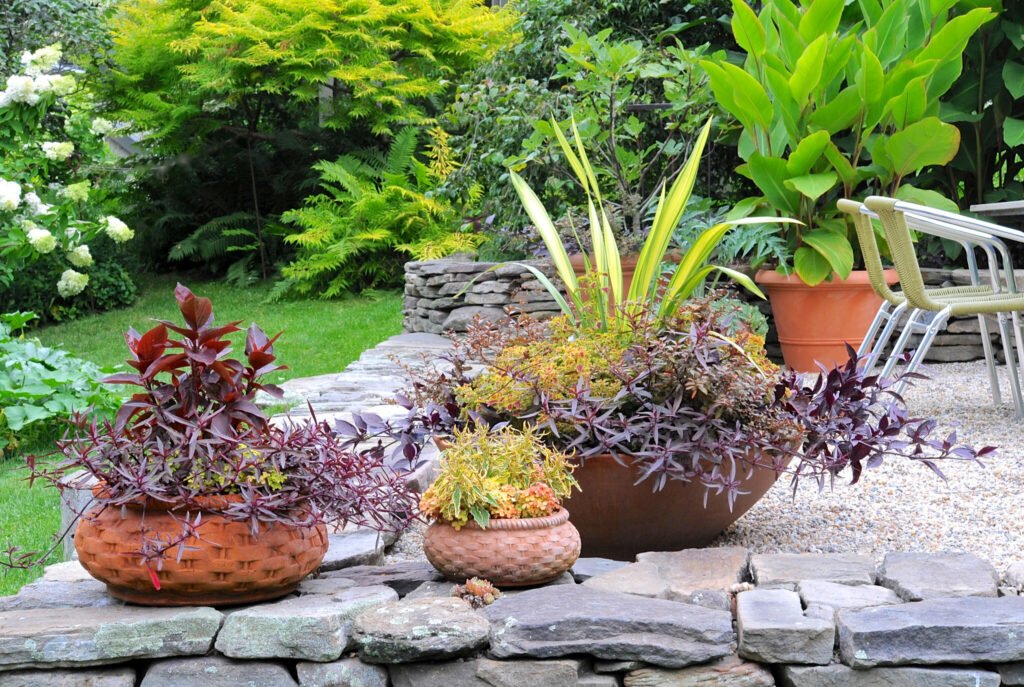
Plant selection plays a crucial role in maintaining a balanced look:
- Height Variation: Place taller plants at the back or center, medium-height plants in the middle, and low-growing or trailing plants at the edges.
- Foliage and Texture: Combine different leaf shapes and textures to add depth. Smooth, broad leaves contrast nicely with fine, feathery foliage.
- Color Harmony: Group plants with complementary or analogous colors. For example, pairing purples with greens creates a calming effect, while contrasting colors add vibrancy.
- Growth Habit: Mix upright, bushy, and trailing plants. Trailing plants soften the edges of containers and connect individual pots visually.
By thoughtfully selecting plants, gardeners can enhance container arrangements and create a cohesive, inviting garden.
4. Principles of Container Placement
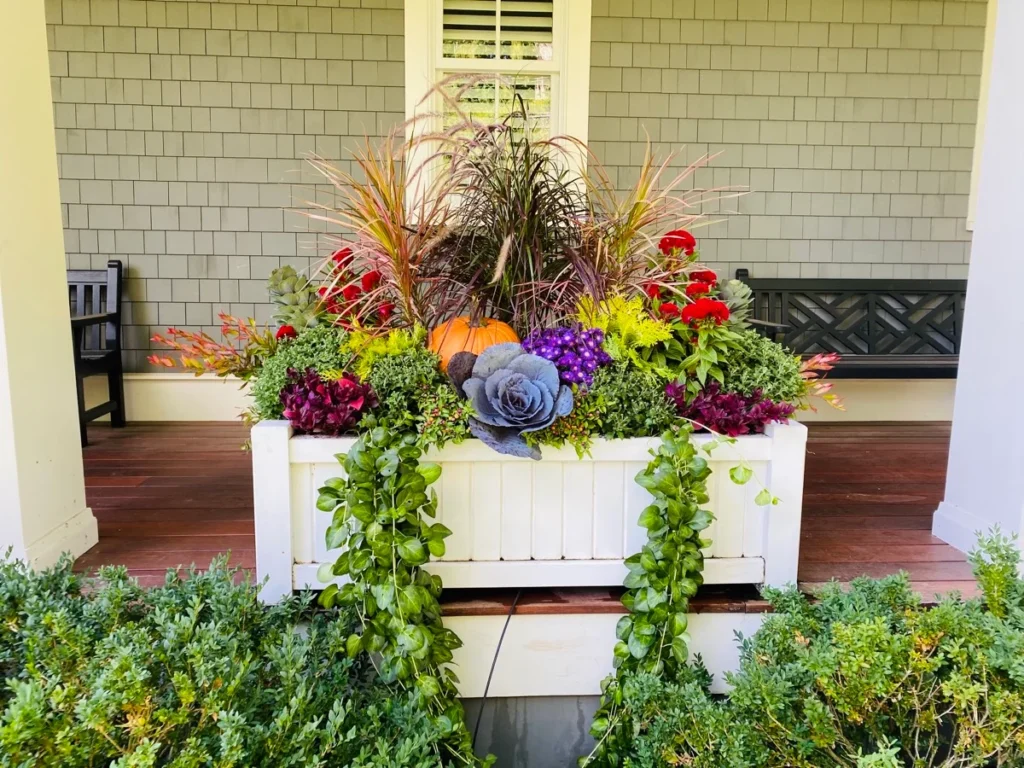
The way containers are placed affects the visual flow and balance of the garden:
Height and Layering
- Taller containers or plants should be placed at the back or center of the display.
- Medium-height containers act as transitional layers between tall and low plants.
- Low and trailing plants soften edges and lead the eye naturally across the arrangement.
Grouping
- Containers arranged in odd numbers (3, 5, 7) generally feel more visually appealing.
- Groupings can be based on size, color, or plant type, creating a sense of unity.
- Avoid linear rows unless a formal symmetrical look is intended.
Focal Points
- Use a unique container, vibrant plant, or decorative element as a central focal point.
- Position other containers around the focal point to maintain balance.
- Focal points anchor the arrangement and draw attention naturally.
Spacing
- Leave enough space between containers for air circulation and growth.
- Proper spacing prevents visual clutter and ensures plants thrive without competition.
5. Incorporating Vertical and Multi-Level Arrangements
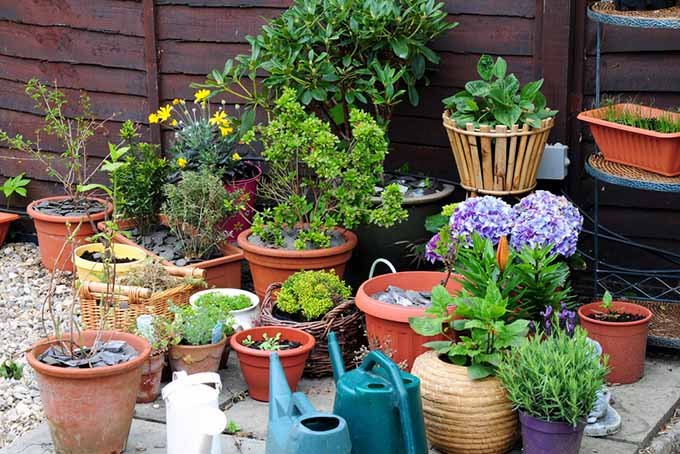
Utilizing vertical space enhances balance, particularly in small areas:
- Tiered Plant Stands: Place containers at varying heights to create visual layers and maximize planting area.
- Hanging Containers: Ideal for trailing plants, adding softness and depth to the arrangement.
- Wall-Mounted Planters: Efficient for balconies or patios, keeping the floor clear and maintaining symmetry.
- Stacked Pots: Nest smaller pots on larger ones to save space and add dimension.
Vertical arrangements draw the eye upward and make small spaces appear larger while maintaining a cohesive, balanced design.
6. Color and Texture Strategies
Colors and textures influence perception of balance:
- Monochromatic Scheme: Using shades of one color creates a serene, cohesive look.
- Complementary Colors: Colors opposite each other on the color wheel (like purple and yellow) make the arrangement dynamic and lively.
- Texture Contrast: Pair smooth leaves with spiky or feathery foliage to add depth and interest.
- Container Finish: Glossy containers reflect light and draw attention, while matte finishes provide subtle grounding.
By combining color and texture thoughtfully, gardeners can enhance balance and aesthetic appeal in container arrangements.
7. Creating Pathways and Visual Flow
Arranging containers to guide the eye improves both functionality and visual balance:
- Pathway Framing: Line containers along edges or pathways to create symmetry and lead visitors through the garden.
- Curved Lines: Curved arrangements feel more organic and relaxed than strict linear placements.
- Zoning: Group containers into zones based on plant type, height, or color to create visual order.
- Repetition: Repeat container shapes, colors, or plant varieties to establish rhythm and continuity.
Pathways and visual flow enhance the perception of space and make small garden areas feel expansive.
8. Seasonal Adjustments
Container gardens evolve with the seasons, and arrangements should adapt accordingly:
- Spring/Summer: Use fast-growing, flowering plants and bright foliage to create vibrant displays.
- Autumn/Winter: Replace seasonal flowers with evergreens, ornamental grasses, or hardy shrubs for structure.
- Rotation: Rotate containers or plants periodically to maintain even sunlight exposure and healthy growth.
Adapting container placement seasonally ensures a consistent balanced look year-round.
9. DIY and Budget-Friendly Tips
Creating a balanced garden does not require expensive materials:
- Recycled Containers: Use old jars, buckets, crates, or furniture to hold plants.
- Paint and Decor: Customize inexpensive containers with paint or fabric to match color schemes.
- DIY Trellises: Bamboo sticks or repurposed rods serve as supports for climbing plants.
- Mix High and Low-Cost Plants: Combine a few premium plants with affordable options for visual appeal.
DIY solutions allow gardeners to achieve a professional look without overspending.
10. Maintenance for Balanced Beauty
A balanced garden look requires ongoing care:
- Pruning and Trimming: Remove dead or overgrown foliage to maintain shape and prevent imbalance.
- Repositioning: Adjust container placement as plants grow to maintain height harmony.
- Cleaning: Wipe dusty leaves and clean containers to keep the arrangement fresh.
- Regular Watering and Fertilization: Healthy plants naturally contribute to visual balance through lush growth and vibrant colors.
Consistent maintenance ensures that the arrangement remains attractive and harmonious over time.
11. Combining Functionality with Aesthetics
Beyond visual appeal, container arrangements can serve practical purposes:
- Edible Plants: Arrange herbs, leafy greens, and vegetables for easy harvesting.
- Privacy Screens: Use tall containers with dense foliage to create natural privacy barriers.
- Shade and Microclimates: Position larger pots strategically to shade smaller plants or sensitive species.
- Pollinator-Friendly Plants: Incorporate flowering plants to attract bees and butterflies, enhancing biodiversity.
Functional arrangements enhance both the beauty and utility of the garden space.
Conclusion
Arranging containers for a balanced garden look combines art, science, and creativity. By considering container size, shape, and color, selecting appropriate plants, and employing principles of height variation, grouping, and visual flow, gardeners can transform even small spaces into lush, inviting retreats.
Vertical and multi-level arrangements, color and texture strategies, seasonal adjustments, and ongoing maintenance ensure that the garden remains visually appealing year-round. Budget-friendly DIY solutions further enhance accessibility, proving that creating a harmonious and balanced container garden does not require large spaces or significant investment.
Ultimately, a well-arranged container garden elevates the aesthetic quality of any space, promotes plant health, and enhances the gardener’s connection to nature, creating a serene and sustainable environment in urban or small-scale settings.
